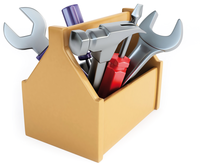Toolbox
Whether it be themes and templates, JavaScript or regex, responsive design or typography, resourceful web designers make work easier for themselves with the many freely available tools on the web.
|

Karel Miragaya, 123RF
Whether it be themes and templates, JavaScript or regex, responsive design or typography, resourceful web designers make work easier for themselves with the many freely available tools on the web.
As a budding web developer, you don't have to search very long to find the right tool to make your web presence known. Many useful tools for designing and testing websites are freely available on the web. I'll look at six of them here.
When working with a popular content management systems (CMSs), such as WordPress, Drupal, or Serendipity, you'll notice no shortage of appealing templates for web design. Each project page usually has a collection developed by the community. In the WordPress Themes directory [1], for example, you can choose from more than 2,500 WordPress templates. Even if you lack in-depth knowledge of web development, you can build an attractive website, although problems may still get in the way. Often, the biggest hurdle is correctly referencing stylesheet elements of the theme. For example, should you write bsp {…} , .bsp {…} , #bsp {…} , or .bsp p {…} in style.css , and what do each refer to?
If you're reluctant to refer to Selfhtml.org to read about CSS selectors, then the CSS Diner [2] can give you some helpful hints about cascading style sheets. The little game has you finding the right selector for each of the 26 levels. Enter your answer in the CSS Editor on the left. The HTML Viewer to the right has the HTML code for the items on the table you need to reference in your answer (Figure 1).
 Figure 1: As a web beginner, you first need to understand the essentials. The CSS Diner will help you with CSS selectors.
Figure 1: As a web beginner, you first need to understand the essentials. The CSS Diner will help you with CSS selectors.
Today's web development combines HTML, CSS, and JavaScript. The HTML code describes only the content; the cascading style sheets define the appearance on the website, and JavaScript lets you integrate dynamic elements. The interaction of these three components may prove tough for budding webmasters, even if you're just applying an existing template. Getting started, it's important to test the different techniques together. With JS Bin [3], this process is easy.
The JS Bin interface (Figure 2) consists of HTML , CSS , JavaScript , Console , and Output panels that you can switch on and off in the menu bar. The panels other than Console and Output have entry fields. The Output shows the results of your entries right away. This control layout was adapted by many similar services, although the arrangement and number of panels differ. The menu bar at the top has a few other settings. Here you can save your bin or set a milestone for archiving. With the Share menu, you can share your bin or allow the code to be embedded in another website. You also have the option of integrating popular frameworks, such as jQuery, MooTools, YUI, and many others.
Pages: 3
Working with the Scribes editor isn't completely automatic, but with a little skill, you can save yourself a lot of typing.
If you want not only to enjoy e-books in EPUB format but also to create them, take a look at the easy-to-use and versatile editor from Sigil.
GIMP by itself can already do a lot. With plugins, you can extend the free image editor with complex functions, most of which allow you to see the final results before you apply them.
Web page loading time relies on a complex interplay among the web server, the web page, and the web browser. Learning a few tricks can help speed up load times for the pages you create.
In an age of perpetually interconnected devices, keeping your network and its services safe and running smoothly is a high priority whether you're an admin or an end-user.
© 2024 Linux New Media USA, LLC – Legal Notice